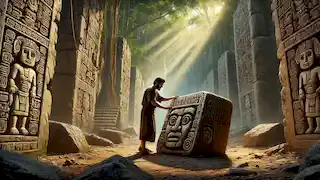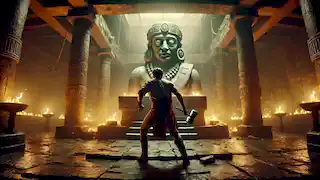In the dense jungles of the Yucatán Peninsula, a relic of an ancient civilization lay half-buried beneath the foliage. The humid air, thick with the scent of earth and decay, whispered of long-forgotten deities and sacrifices made in their honor. Among the sprawling roots of ceiba trees, there was a single figure that seemed to resist the jungle’s attempts to erase it from history—a stone sculpture known as the Chacmool.
The Chacmool, a reclining stone figure with its head turned to one side and its hands resting on its stomach, cradling a dish, was said to represent a messenger between humans and the gods. In ancient Mesoamerican culture, the dish held the hearts of sacrificial victims, a tribute to the gods to ensure balance in the world. But the origins of the Chacmool went far beyond its function in religious ceremonies. Its creation was rooted in a legend that spanned the rise and fall of empires, where gods and humans walked the same earth, and fate was woven through the lives of both. The story begins in the great city of Tula, the capital of the Toltec civilization, where towering pyramids pierced the sky, and the vast plazas echoed with the sound of drums. In the heart of this city, among the priests and warriors, lived a sculptor named Cuauhtémoc. His hands were calloused from years of carving stone, but his mind was sharp, filled with dreams of creating something that would outlast him, a work of art that could bridge the mortal and divine. One night, Cuauhtémoc had a vision. As he lay in his small home, the scent of burning copal incense still clinging to the air, he dreamed of a figure—reclining, its eyes closed in peace but its form ready to bear the weight of the gods. It was neither man nor deity but something in between, a symbol of the cosmic balance. The figure held a bowl, and within it, Cuauhtémoc saw a beating heart, glowing with life and pulsating like the very essence of the universe. Awaking with a start, Cuauhtémoc knew this vision was not a mere dream. It was a calling from the gods themselves. His heart raced with excitement and fear, for he understood the gravity of what he had been shown. To create such a figure would be to invite the attention of the gods, for better or worse. The next morning, Cuauhtémoc sought the guidance of the high priest, Itzamna. Itzamna, a man who had seen many omens and understood the will of the gods, listened carefully as Cuauhtémoc described his vision. The priest’s expression grew grave as the sculptor spoke. “This is not a task to be taken lightly,” Itzamna warned. “To shape the form of the gods is to walk on the edge of life and death. If the gods are displeased, your fate may be sealed.” But Cuauhtémoc was resolute. The vision had been clear, and he could not ignore it. He had seen the figure, the Chacmool, and he believed it was his destiny to bring it into existence. Weeks passed, and Cuauhtémoc began the arduous process of selecting the stone for his masterpiece. He traveled to the sacred quarries of the region, where the finest limestone had been carved for centuries. As he wandered the quarry, a single block of stone seemed to call out to him. It was larger than any he had ever worked with, smooth to the touch yet filled with a hidden strength. This stone, he knew, would become the Chacmool. For months, Cuauhtémoc worked tirelessly. The chisel in his hand became an extension of his will, as if the stone itself knew what it needed to become. As he worked, he recalled the details of his vision—the peaceful face, the reclining posture, the dish held between the figure’s hands. Slowly, the Chacmool took shape, its features emerging from the stone as if it had always been there, waiting to be uncovered. But as Cuauhtémoc neared the completion of his work, strange things began to happen. The air around him grew colder, even in the heat of the midday sun. Whispers seemed to echo from the stone itself, though no one else could hear them. And at night, he dreamed not of his creation, but of the gods themselves—figures of immense power, watching him from the shadows, their eyes filled with judgment. One night, as he finished carving the final details into the figure’s face, Cuauhtémoc felt a presence behind him. Turning, he saw nothing but the empty darkness of his workshop. Yet the feeling remained, as though something ancient and powerful was watching him, waiting for the final stroke of his chisel. And then, it was done. The Chacmool lay before him, a perfect representation of the figure from his dream. But as Cuauhtémoc gazed upon it, a sense of unease settled over him. The Chacmool’s eyes seemed to flicker, just for a moment, as though they had come to life. {{{_02}}} News of Cuauhtémoc’s creation spread quickly through Tula. People came from all corners of the city to see the Chacmool, marveling at its lifelike appearance and the serene power it seemed to exude. Even the high priest, Itzamna, was impressed, though he offered no praise. Instead, he stood in silence before the statue, his eyes narrowed in thought. But as the days passed, strange occurrences began to plague the city. Crops withered in the fields, and the usually calm rivers began to rise, threatening to flood the streets. The people grew fearful, whispering that the gods were angry. Some even blamed Cuauhtémoc, claiming that his creation had displeased the deities and brought a curse upon them all. Desperate to understand what had gone wrong, Cuauhtémoc once again sought the counsel of Itzamna. The priest’s face was grim as he spoke. “The gods are not pleased,” Itzamna said. “Your creation has disrupted the balance. The Chacmool was not meant to exist in this world. You have brought the divine too close to the mortal, and now we must pay the price.” Cuauhtémoc’s heart sank. He had thought he was fulfilling the will of the gods, but now it seemed he had only angered them. As the floods rose and the people’s fear turned to anger, Cuauhtémoc knew he had to act. He could not allow his creation to bring ruin to the city he loved. In a final act of desperation, Cuauhtémoc decided to destroy the Chacmool. He believed that if he returned the stone to the earth, the gods might forgive him and restore balance to the world. That night, under the cover of darkness, Cuauhtémoc crept to the temple where the Chacmool was housed. With a heavy heart, he raised his hammer, preparing to strike the stone and undo the work of his hands. But before he could bring the hammer down, the air around him grew still. A voice, deep and ancient, echoed through the chamber. “Do not destroy what you have created,” the voice said. “The gods have taken notice of your work, and though they are angered, they offer you a choice. Leave the Chacmool, and the curse will be lifted. But you must give yourself to the gods as payment.” Cuauhtémoc trembled at the voice, understanding that it was no mere hallucination but the will of the gods themselves. He knew what he had to do. His life, for the salvation of his people. The next morning, Cuauhtémoc stood before the temple, where the high priest and the people of Tula awaited. In his hands, he held the tools of his trade—his chisel and hammer. But today, he would not use them for creation. Today, they would serve as symbols of his sacrifice. The people watched in silence as Cuauhtémoc ascended the steps of the great pyramid, where the altar to the gods awaited. The sky was dark with storm clouds, but no rain fell. It was as though the heavens themselves were holding their breath, waiting for the moment of atonement. As he reached the top of the pyramid, Cuauhtémoc knelt before the altar, his heart steady despite the fear that coursed through him. He had made his choice. The gods demanded balance, and he would give it to them. The high priest, Itzamna, stood over him, his hands raised in prayer to the gods. As the chants filled the air, Cuauhtémoc closed his eyes, feeling the presence of the Chacmool behind him. Though he could not see it, he knew that the statue, his creation, was watching him, its eyes now fully open. And then, with a single, swift motion, the sacrifice was made. Cuauhtémoc’s life was given to the gods, and as his blood soaked the altar, the storm clouds parted. The curse was lifted, and the city of Tula was saved. But the Chacmool remained, a silent witness to the sacrifice. Its dish, once empty, now held the heart of the man who had created it, a tribute to the gods that would last for all eternity. Years passed, and the story of Cuauhtémoc and the Chacmool became legend. The people of Tula revered the statue, understanding it not as a curse, but as a symbol of the delicate balance between the mortal and the divine. It stood in the temple, untouched by time, a reminder of the power of the gods and the sacrifice of one man. As the Toltec civilization faded and new empires rose in its place, the Chacmool was carried with them. It became a central figure in the rituals of the Maya and later the Aztec, who saw it as a messenger between the human and the divine, a conduit through which the gods could be appeased. But even as the centuries passed and empires crumbled, the Chacmool remained. It was more than a mere sculpture—it was a reminder that the line between the mortal and the divine was thin, and that to cross it was to invite both greatness and destruction. And so, in the dense jungles of the Yucatán, where the ancient cities now lay in ruins, the Chacmool still rests, half-buried beneath the earth. Its eyes, though closed, watch over the world, waiting for the day when the gods will once again demand balance. And the legend of Cuauhtémoc, the sculptor who dared to shape the will of the gods, lives on, carried by the wind through the trees, a story that will never be forgotten.The Dream of Stone

The Stone of Creation
The Curse of the Gods

The Sacrifice of Cuauhtémoc
Legacy of the Chacmool


















